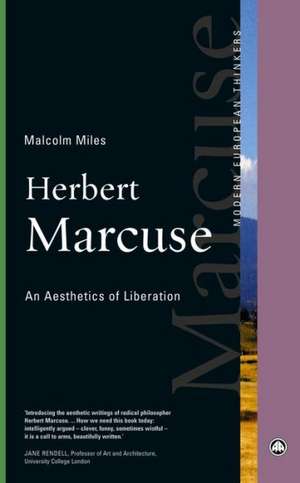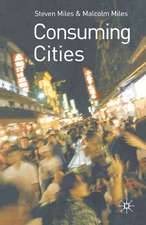Herbert Marcuse: An Aesthetics of Liberation
Autor Malcolm Milesen Limba Engleză Paperback – 4 dec 2011
Although Marcuse is best known as a critic of consumer society, epitomised in the classic One-Dimensional Man, Malcolm Miles provides an insight into how Marcuse's aesthetic theories evolved within his broader attitudes, from his anxiety at the rise of fascism in the 1930s through heady optimism of the 1960s, to acceptance in the 1970s that radical art becomes an invaluable progressive force when political change has become deadlocked.
Marcuse's aesthetics of liberation, in which art assumes a primary role in interrupting the operation of capitalism, made him a key figure for the student movement in the 1960s. As diverse forms of resistance rise once more, a new generation of students, scholars and activists will find Marcuse’s radical theory essential to their struggle.
| Toate formatele și edițiile | Preț | Express |
|---|---|---|
| Paperback (1) | 293.27 lei 6-8 săpt. | |
| PLUTO PRESS – 4 dec 2011 | 293.27 lei 6-8 săpt. |
Preț: 293.27 lei
Nou
Puncte Express: 440
Preț estimativ în valută:
56.12€ • 58.59$ • 46.44£
56.12€ • 58.59$ • 46.44£
Carte tipărită la comandă
Livrare economică 04-18 aprilie
Preluare comenzi: 021 569.72.76
Specificații
ISBN-13: 9780745330389
ISBN-10: 074533038X
Pagini: 208
Ilustrații: 3 black & white images
Dimensiuni: 135 x 215 x 13 mm
Greutate: 0.25 kg
Editura: PLUTO PRESS
Colecția Pluto Press
ISBN-10: 074533038X
Pagini: 208
Ilustrații: 3 black & white images
Dimensiuni: 135 x 215 x 13 mm
Greutate: 0.25 kg
Editura: PLUTO PRESS
Colecția Pluto Press
Notă biografică
Malcolm Miles is Professor of Cultural Theory in the School of Architecture, Design & Environment, University of Plymouth; Visiting Professor of Aesthetics and Urban Regeneration in the School of Sociology & Criminology, Keele University; and author of Herbert Marcuse: an Aesthetics of Liberation (2011).
Cuprins
Introduction
1. Aesthetics and the Reconstruction of Society
2. The Artist and Social Theory
3. Affirmations
4. A Literature of Intimacy
5. Society as a Work of Art
6. The End of Utopia
7. The Aesthetic Dimension
8. Legacies and Practices
Notes
Index
1. Aesthetics and the Reconstruction of Society
2. The Artist and Social Theory
3. Affirmations
4. A Literature of Intimacy
5. Society as a Work of Art
6. The End of Utopia
7. The Aesthetic Dimension
8. Legacies and Practices
Notes
Index
















